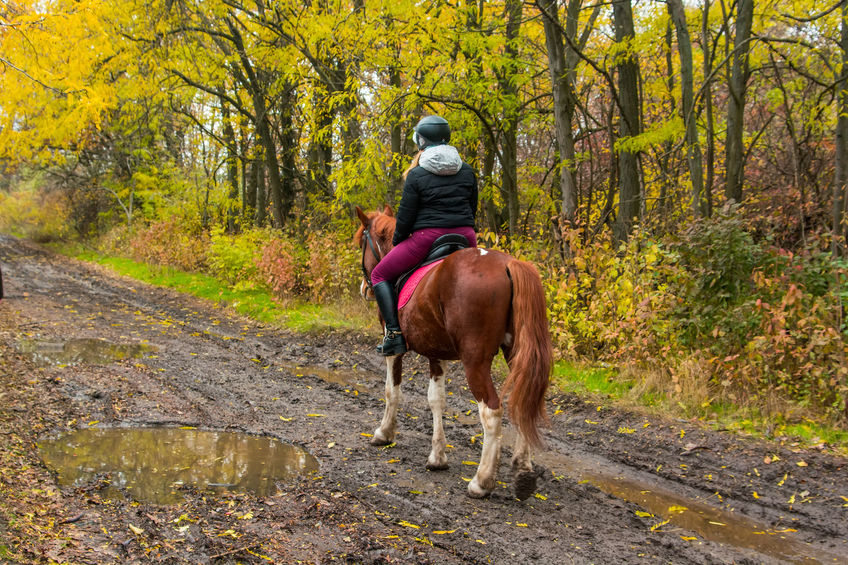 Fall is a beautiful season that entices equestrians to explore trails filled with stunning, colorful landscapes. However, it also brings its own unique hazards. This guide will help you navigate these challenges by highlighting potential trail riding dangers and offering practical tips to ensure your ride is enjoyable and safe!
Fall is a beautiful season that entices equestrians to explore trails filled with stunning, colorful landscapes. However, it also brings its own unique hazards. This guide will help you navigate these challenges by highlighting potential trail riding dangers and offering practical tips to ensure your ride is enjoyable and safe!
Wet and Slippery Terrain
Autumn weather can be unpredictable. One day, it may be sunny, while the next day, there could be a downpour or slippery morning dew. Slippery trails can cause horses to lose their footing, which can be dangerous—choosing horseshoes that have adequate traction and slow your pace while on the trail is important. Allow your horse to take its time, especially when going downhill. Trust your horse’s instincts because they can usually find the safest path.
Fallen Leaves and Hidden Obstacles
A beautiful sight during the fall season is a thick layer of fallen leaves covering the ground. However, it is important to stay cautious of potential dangers hidden under the carpet of leaves. Rocks, holes, and tree roots can easily trip up an unsuspecting horse. Sticking to well-trodden paths you are familiar with is recommended, especially during peak fall leaf coverage. If you are exploring new areas, riding slowly and keeping a keen eye on the ground ahead to avoid any hazards is best.
Unpredictable Weather Conditions
It can be difficult for both rider and horse to deal with sudden weather changes in the fall season. It is important to check the weather forecast before heading out to avoid any problems. Pack a lightweight, waterproof jacket and ensure your horse’s equipment is appropriate for any weather changes.
Decreased Daylight
As winter approaches, the days become shorter, leaving us with limited riding hours. At dusk, visibility can be significantly reduced, increasing the risk of accidents. To avoid such mishaps, completing your rides well before sunset is advisable. However, if you end up riding later than expected, wearing reflective gear and clip-on lights is crucial, as they can make all the difference in visibility and safety.
Wildlife Activity
As autumn sets in, many animals become active, preparing for winter or migrating. This increases the chances of encountering wildlife on the trail, such as deer, foraging bears, or smaller critters. To reduce the chances of your horse getting spooked, it is important to regularly expose them to wildlife in controlled environments. If you come across wildlife, speak calmly and give them ample space and opportunity to move away.
Seasonal Hunting
In many areas, fall means hunting season. This poses a risk for riders who might inadvertently wander into hunting zones. Familiarize yourself with local hunting seasons and locations and wear bright or fluorescent colors when riding, making it clear you’re not game.
Temperature Drops and Equine Health
A brisk fall ride can be invigorating, but a sharp temperature drop can be tough on your horse, leading to muscle stiffness or respiratory challenges. Ensure your horse is adequately warmed up before picking up the pace. If it’s particularly cold, consider equine jackets or blankets post-ride to keep them warm.
By being aware of these seasonal hazards and preparing accordingly, you can enjoy each ride, confident that you’re doing your best to ensure your and your steed’s well-being.
Investing in a proper shelter is a must for those who truly value their horse’s comfort during the changing seasons. Ensuring they have a safe and cozy space to return to after a day on the trails is paramount. At Deer Creek Structures, every detail of a custom horse barn or run-in shed is crafted with your equine companion in mind.
Browse our website to view what we have in stock, and fill out our contact form online to request more information on our custom horse structures today!
